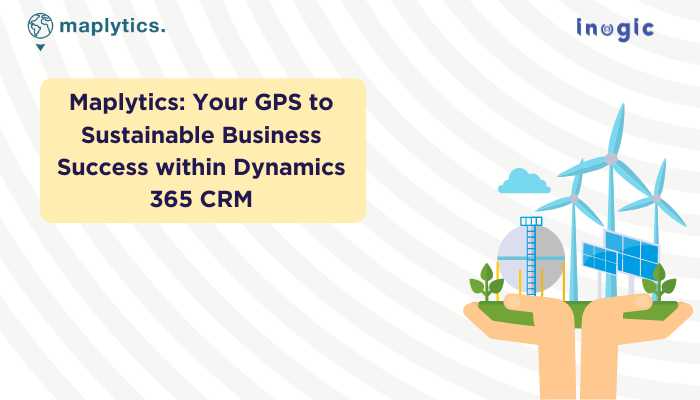In today’s environmentally conscious landscape, businesses are increasingly prioritizing sustainability. However, achieving long-term success goes beyond simply using recycled materials or planting trees. It requires a proactive approach that minimizes environmental impact, optimizes resource utilization, and fosters efficient operations. Here’s where Maplytics, a powerful geo-mapping and analytics tool integrated with Microsoft Dynamics 365 / Dataverse, emerges as a game-changer. Let’s explore how Maplytics empowers businesses to navigate the path toward a sustainable future.
Sustainability Challenges:
Businesses face a multitude of sustainability challenges:
- Supply Chain Disruptions: Climate change-induced extreme weather events like floods and hurricanes can disrupt transportation networks and damage infrastructure, leading to shortages of raw materials and delays in product delivery.
- Resource Depletion: Unsustainable resource usage, such as over-extraction of water or deforestation, can impact the environment and disrupt production processes.
- Carbon Footprint Reduction: Meeting emissions reduction targets and minimizing the environmental impact of operations is crucial for businesses striving for sustainability.
- Waste Management: Optimizing waste management practices not only benefits the environment but also reduces disposal costs.
- Transparency and Compliance: Consumers are increasingly demanding eco-friendly practices. Businesses need transparent and data-driven methods to demonstrate their sustainability efforts and comply with evolving environmental regulations.
These challenges mark the need for innovative solutions that are adjusting and promote responsible business practices.
Maplytics: A Sustainability Toolkit
Maplytics offers a robust toolkit to help businesses navigate sustainability challenges:
- Risk Assessment and Planning: By leveraging geospatial data and analytics, Maplytics allows businesses to identify areas vulnerable to climate change impacts, such as flooding or drought risk zones. This enables proactive planning and mitigation strategies to minimize disruptions and safeguard resources.
- Sustainable Supply Chain Management: Maplytics helps analyze transportation routes and associated carbon emissions with deliveries. Businesses can use this data to choose more optimized routes and efficient logistics, and potentially reduce their overall carbon footprint. Additionally, Maplytics can help identify local, sustainable suppliers, minimizing transportation distances and contributing to a more sustainable supply chain ecosystem.
- Resource Management and Optimization: From water usage monitoring to analyzing land for sustainable agricultural practices, Maplytics allows businesses to track and optimize resource utilization. This data-driven approach can help businesses conserve valuable resources, reduce waste, and minimize their environmental impact.
- Site Selection: Maplytics can be used to evaluate potential real estate options based on environmental factors like proximity to renewable energy sources or proximity to waste disposal facilities that prioritize recycling. This data allows businesses to make informed decisions for sustainable facility management and development.
Businesses in Action
Here’s how some companies could leverage Maplytics for sustainability efforts:
- Manufacturing Company: A manufacturing company could utilize Maplytics to analyze transportation routes and identify facilities with lower energy consumption rates. This knowledge would allow them to optimize logistics, reduce emissions, and prioritize energy-efficient production practices.
- Agriculture Firm: An agricultural company could use Maplytics to monitor soil health and water usage across their farms on heat maps. This data could help them implement sustainable irrigation practices, optimize crop yield, and minimize water waste.
- Logistics Company: A logistics company can leverage Maplytics to analyze traffic patterns and choose the most efficient routes for deliveries. This would reduce fuel consumption, minimize emissions, and promote sustainable transportation practices.
Collaboration for a Sustainable Future
Building a sustainable future requires collective action. Businesses can collaborate with environmental organizations and government agencies to share data and best practices. Maplytics’ data visualization and communication tools can facilitate knowledge sharing and collaboration, enabling businesses to develop a more comprehensive understanding of their environmental impact and implement effective sustainability strategies.
Empowering Businesses to Thrive Sustainably
Sustainability is no longer a luxury but a business imperative. By embracing innovative solutions like Maplytics, businesses gain valuable insights, optimize operations for reduced environmental impact, and build resilience in the face of climate challenges. Maplytics empowers companies to not only minimize their environmental footprint but also demonstrate their commitment to a sustainable future, enhancing their brand image and attracting eco-conscious consumers. Taking a proactive approach with tools like Maplytics allows businesses to thrive long-term, ensuring a sustainable future for generations to come.
What’s More?
Maplytics is like water that can be moulded into any role. To get more acquainted and experience it first-hand, one can write to crm@inogic.com To investigate the product further, with a personalized demo within Microsoft Dynamics 365 CRM / Dataverse get in touch with the team.
For applied knowledge, do visit our Website or Microsoft AppSource. One can hop on to the detailed Blogs, Client Testimonials, Success Stories, Industry Applications, and Video Library for a quick query resolution.
Until then,
Happy Sustenance!




